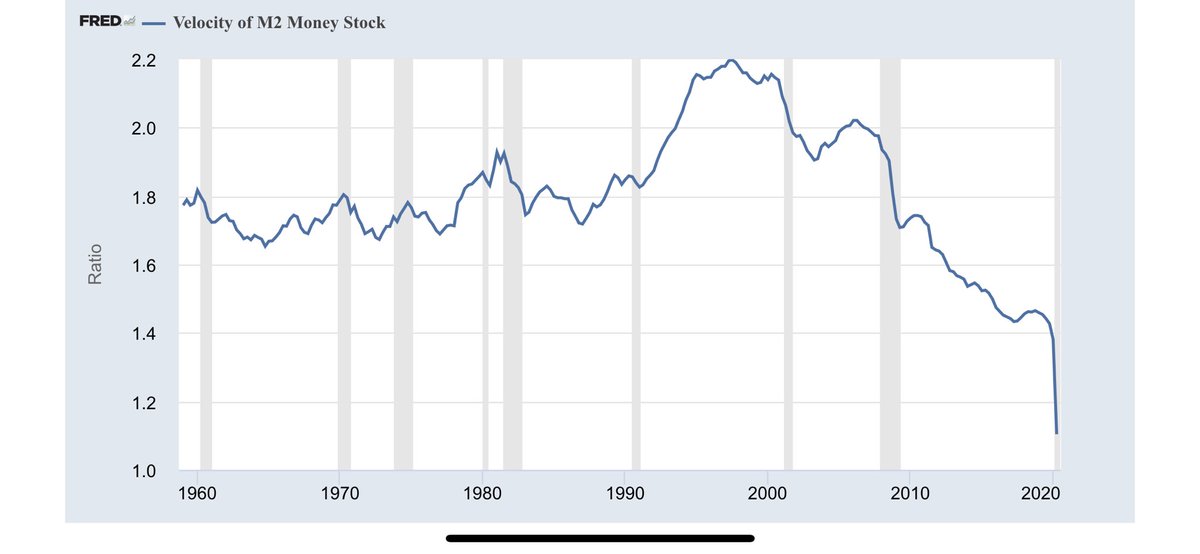
Some thoughts after reading @coloradotravis’s provocative thread.
In preview, I disagree with Travis that inflation is not what comes next.
If you think I’m missing something, or I’m flat out wrong, please say so.
In preview, I disagree with Travis that inflation is not what comes next.
If you think I’m missing something, or I’m flat out wrong, please say so.
https://twitter.com/coloradotravis/status/1296853677253124096
1- I submit that the sole purpose of QE, contrary to what Travis implies, is not to provide additional collateral to banks.
If that were the sole purpose, then banks would not already have a zero- collateral requirement.
If that were the sole purpose, then banks would not already have a zero- collateral requirement.
1A- Which they do, thanks to a rule change by the Fed, made effective on March 26th:
"...the Board reduced reserve requirement ratios to zero percent... This action eliminated reserve requirements for all depository institutions."
Link: federalreserve.gov/monetarypolicy…
"...the Board reduced reserve requirement ratios to zero percent... This action eliminated reserve requirements for all depository institutions."
Link: federalreserve.gov/monetarypolicy…
2- So if banks have a zero-collateral requirement, then it’s safe to say they don’t need the Fed to print money in order for them to lend more.
They only need more motivation and risk appetite, which they presently lack due to the state of our ailing economy.
They only need more motivation and risk appetite, which they presently lack due to the state of our ailing economy.
3- Rather, the Fed is printing money primarily (though not exclusively) to lend to the US government by purchasing USTs.
The govt, in turn, is slowly injecting this newly printed money into the bloodstream of the economy by giving it directly to individuals and corporations.
The govt, in turn, is slowly injecting this newly printed money into the bloodstream of the economy by giving it directly to individuals and corporations.
3A- This is very impt, as it represents a shift from asset inflation to price inflation via increased fiscal measures financed by the Fed.
While efforts to stoke price inflation in the last 20 odd years have not succeeded, don’t be fooled: money creation is still inflationary.
While efforts to stoke price inflation in the last 20 odd years have not succeeded, don’t be fooled: money creation is still inflationary.
3B- It’s just that it shows up in different places depending on how the printed money is allocated.
Basically, it can be allocated either to production (i.e. capital, which spurs asset inflation), or consumption (i.e. labor, which spurs price inflation).
HT @jam_croissant
Basically, it can be allocated either to production (i.e. capital, which spurs asset inflation), or consumption (i.e. labor, which spurs price inflation).
HT @jam_croissant
https://twitter.com/jam_croissant/status/1315143943596670980
5- In addition, I don’t think @coloradotravis is framing the question correctly to get a proper sense of the future of the purchasing power of the dollar.
The question we should be asking is, what would have happened had the Fed not printed these trillions of dollars? ...
The question we should be asking is, what would have happened had the Fed not printed these trillions of dollars? ...
6- And I think we can all agree that the entire corporate domino world would have collapsed and taken the whole banking system with it.
It would not have been a pretty sight...
It would not have been a pretty sight...
7- Now, do you think the problem has been solved or the collapse averted?
Or, do you think that they just covered up the unsupportable levels of debt by creating more debt, and covered up the unsupportable levels of economic distortions by creating more economic distortions?
Or, do you think that they just covered up the unsupportable levels of debt by creating more debt, and covered up the unsupportable levels of economic distortions by creating more economic distortions?
8- If you believe the latter, as I do, that not only has the Fed not solved the problem but in fact made it worse, then I must ask:
What will happen the next time the economy crashes, as it inevitably will due to the now greater levels of debt and economic distortions?
What will happen the next time the economy crashes, as it inevitably will due to the now greater levels of debt and economic distortions?
9- You guessed it. The next crash will be far greater than the previous (aside: it may involve the implosion of highly levered R-P funds, as explained in pinned tweet).
Then, in response to that, the Fed will have no choice but to print even greater sums to “avoid” the collapse.
Then, in response to that, the Fed will have no choice but to print even greater sums to “avoid” the collapse.
10- So now let’s do several iterations of this and imagine what will happen to the purchasing power of our money...
Zimbabwe anyone?
Zimbabwe anyone?
11- Ok, Ok... Fine. Likening the US to Zimbabwe is not really fair, given that nobody cares about the Zimbabwe Dollar except for Zimbabweans (if even them), and the USD has tremendous external demand for its currency.
12- But in relation to the stuff we need to survive & prosper, I don’t see how, esp. after a few more iterations of ‘crash & print’, the dollar’s value could rise from here.
I mean, how can you honestly think this sort of money creation portends anything but further debasement?

I mean, how can you honestly think this sort of money creation portends anything but further debasement?


@coloradotravis @profplum99 @pineconemacro @SantiagoAuFund @EmilKalinowski @MetreSteven @LynAldenContact @LukeGromen @RaoulGMI @Convertbond @GaricMoran @LawrenceLepard.
What am I missing? Help me see it. Any feedback/criticisms always welcome and appreciated.
What am I missing? Help me see it. Any feedback/criticisms always welcome and appreciated.
• • •
Missing some Tweet in this thread? You can try to
force a refresh





